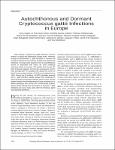Autochthonous and Dormant Cryptococcus gattii Infections in Europe
Hagen, Ferry
Colom, M. Francisca
Swinne, Daniëlle
Tintelnot, Kathrin
Iatta, Roberta
Montagna, Maria Teresa
Torres-Rodriguez, Josep M.
Cogliati, Massimo
Velegraki, Aristea
Burggraaf, Arjan
Kamermans, Alwin
Sweere, Johanna M.
Meis, Jacques F.
Klaassen, Corné H.W.
Boekhout, Teun
Until recently, Cryptococcus gattii infections occurred mainly in tropical and subtropical climate zones. However, during the past decade, C. gattii infections in humans and animals in Europe have increased. To determine whether the infections in Europe were acquired from an autochthonous source or associated with travel, we used multilocus sequence typing to compare 100 isolates from Europe (57 from 40 human patients, 22 from the environment, and 21 from animals) with 191 isolates from around the world. Of the 57 human patient isolates, 47 (83%) were obtained since 1995. Among the 40 patients, 24 (60%) probably acquired the C. gattii infection outside Europe; the remaining 16 (40%) probably acquired the infection within Europe. Human patient isolates from Mediterranean Europe clustered into a distinct genotype with animal and environmental isolates. These results indicate that reactivation of dormant C. gattii infections can occur many years after the infectious agent was acquired elsewhere.
Dateien zu dieser Publikation
Keine Lizenzangabe

